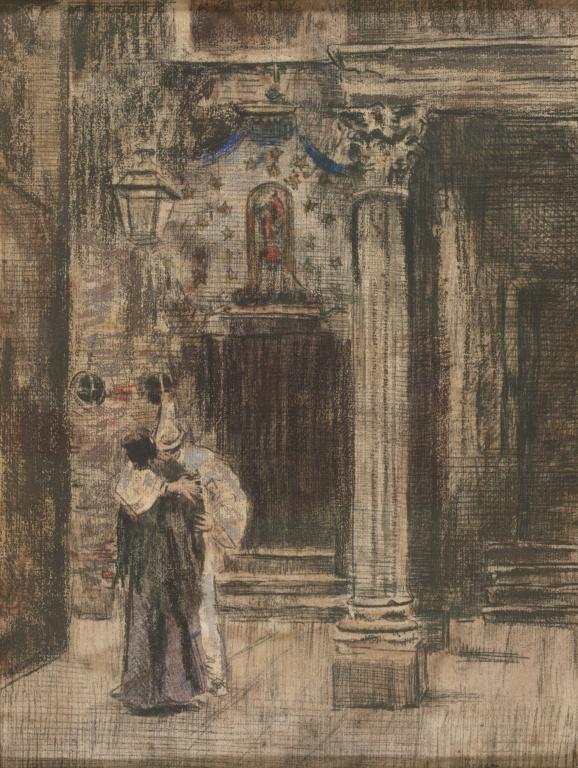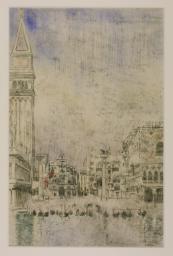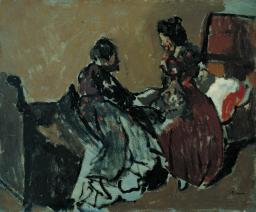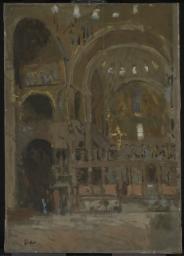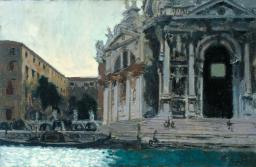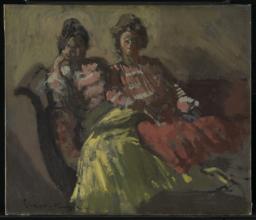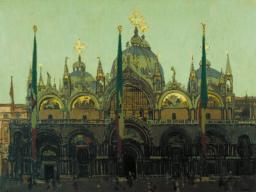Walter Richard Sickert Pierrot and Woman Embracing c.1901
Walter Richard Sickert,
Pierrot and Woman Embracing
c.1901
This scene may have been observed by Sickert during the Carnival of Venice. Two figures, including one in typical Pierrot costume, embrace in the Campielo de la Sacrestia alleyway, isolated from the city’s bustle. Above the doorway to the Scuola di San Martino is a statue of the Virgin. Pierrot was a Commedia dell’arte character of buffoonery as well as sadness whose humiliations resonated with artists and writers as a metaphor for the experience of modern life.
Walter Richard Sickert 1860–1942
Pierrot and Woman Embracing
c.1901
Gouache and chalk on paper
410 x 311 mm
Inscribed by the artist ‘Sickert’ bottom right
Bequeathed by Lady Henry Cavendish-Bentinck 1940
N05095
c.1901
Gouache and chalk on paper
410 x 311 mm
Inscribed by the artist ‘Sickert’ bottom right
Bequeathed by Lady Henry Cavendish-Bentinck 1940
N05095
Ownership history
... ; Lord Henry Cavendish-Bentinck (1863–1931); inherited by his wife, Lady Henry Cavendish-Bentinck, in 1931, by whom bequeathed to Tate Gallery 1940.
Exhibition history
1989–90
W.R. Sickert: Drawings and Paintings 1890–1942, Tate Gallery, Liverpool, March 1989–February 1990, Tate Gallery, London, July–September 1990 (30, reproduced).
2009
Sickert in Venice, Dulwich Picture Gallery, London, March–May 2009 (38, reproduced).
References
1960
Lillian Browse, Sickert, London 1960, p.103.
1964
Mary Chamot, Dennis Farr and Martin Butlin, Tate Gallery Catalogues: The Modern British Paintings, Drawings and Sculpture, vol.2, London 1964, p.632.
1973
Wendy Baron, Sickert, London 1973, p.328.
2006
Wendy Baron, Sickert: Paintings and Drawings, New Haven and London 2006, no.185.2.
Technique and condition
Pierrot and Woman Embracing is a carbon paper tracing with added pastel, watercolour and gouache on laid paper. The paper is light weight and off-white in tone and is in a fragile state and cockled. The sheet was originally 48 mm longer in height and width; the left and lower edges were turned under and became so brittle that they were eventually removed. The underdrawing of this work, which primarily consists of rows of lightly applied parallel lines to create depth and shadow, was probably achieved by tracing through carbon paper. As with the other carbon tracings by Sickert in the Tate collection, Dieppe, Study No 2: Facade of St Jacques (N05094) and Sketch for ‘The Statue of Duquesne, Dieppe’ (N05096), several sheets of carbon paper have been used; pin holes found along the top edge of the work indicate that pins were probably used to register the papers during the process of tracing. Black, brown, brown/red and blue pastel, washes of watercolour and gouache were applied after the carbon tracing to embellish and emphasise certain elements of the image. In comparison to the three other carbon tracings in the Tate collection (see also N03810), where the images primarily consist of dark outlines tinted with watercolour washes, this drawing is heavily worked in terms of additional media with less of the paper surface exposed, giving it a more finished appearance.
Kate Jennings
June 2005
How to cite
Kate Jennings, 'Technique and Condition', June 2005, in Robert Upstone, ‘Pierrot and Woman Embracing c.1901 by Walter Richard Sickert’, catalogue entry, May 2009, in Helena Bonett, Ysanne Holt, Jennifer Mundy (eds.), The Camden Town Group in Context, Tate Research Publication, May 2012, https://wwwEntry
In previous Tate catalogues this drawing has been dated to c.1903–4. But as Wendy Baron, author of the 2006 catalogue raisonné of Sickert’s paintings and drawings, has pointed out its draughtsmanship, and the handling of paint in the finished oil version, suggest an earlier dating of c.1901.1 Additionally, this is most probably the drawing Sickert described as ‘the Pierrot and popolana’ in a letter to his patron Mrs Hulton in 1901, which he said he had sent to the Fine Art Society in London from Venice.2 Sickert’s Venetian pictures from 1901 were generally cityscapes of familiar landmarks, and the only other figure subjects he is known to have made are an oil portrait of the restaurateur and vegetable wholesaler Signor de Rossi,3 and a drawing of Mrs Hulton.4 When he returned to Venice in 1903, Sickert had an artistic breakthrough: he began depicting pairs of figures in ambiguous scenes, as in A Marengo and Le Tose (Tate N03621 and N05296). In Neuville in 1902 Sickert had experimented with making a small number of drawings of a nude model in a bedroom;5 but the setting of pairs of figures in distinct arrangements in his Venetian works was a new development. In such works, Sickert seems to deploy his models like actors on a stage, at once putting them in naturalistic poses but ones that are in fact highly contrived, thus creating dramatic tension. We might view Pierrot and Woman Embracing as some sort of transitional work in this process of evolution.
The action takes place outdoors, away from the bustle of tourist Venice. The viewer is cast almost in the role of voyeur, glimpsing an erotically charged moment of intimacy. The costumes of the Pierrot and his companion suggest this may be a scene during the Carnival of Venice, a time notorious as a period of revelry, and, in particular, sexual intrigue and licence. The masks people wore for anonymity and the relaxation of social codes concerning sexual relations encouraged a proliferation of fleeting liaisons. Traditionally, the carnival started on 2 February and ended the day before Ash Wednesday. By the time Sickert was in Venice, carnival was reportedly somewhat in abeyance, although it had perhaps not completely died out. In the closing decades of the nineteenth century, pictures of Venetian working class life were extremely popular, with fisher girls being a particularly favourite subject in the Royal Academy annual exhibitions (see Tate N05296).
The fascination with such figures was somewhat prurient; innocent scenes of fisher folk flirtation nevertheless alluded to a Mediterranean stereotype of a society more socially, and perhaps morally, relaxed than Victorian Britain. In critical responses to such works the women were habitually described as ‘vivacious’ or ‘Titianesque’, terms that appear to be ciphers for female sexual desire. A further context was the widely held contemporary conviction that Venice itself was a place of moral degradation. As the art historian Alastair Grieve has noted, one of the leitmotifs of Ruskin’s Stones of Venice (1851–3) was his belief that the fall of Venice’s power as a city state was an inevitable effect of the moral decay of its populace.6 In this scheme, the physical crumbling of Venice’s architectural heritage mirrored or expressed the moral excess of its people.
Whether the scene was wholly invented by Sickert or based on observation cannot be known. His rendering of the architectural detail of the setting is extremely precise, and must have been based either on detailed drawings or photographs. The spot he shows is the Campielo de la Sacrestia, an alley that runs along the left side of the church of San Martino, very close to the entrance to the Arsenal.7 Dating from 1540, San Martino was designed by Jacopo Sansovino (1486–1570). The columns are part of the church, a side entrance on its left, and the adjacent building is the former Scuola di San Martino, premises of the confraternity of caulkers. Above the Scuola’s doorway is a statue of the Virgin.
Dressed in the trademark white costume with black pompoms, Pierrot was a staple of the Italian Commedia dell’arte. His hapless antics and buffoonery were a rich source of comedy, but he was also a figure of sadness and longing who inspired sympathy. His unfulfilled amorous pursuit of Columbine allowed great pantomime potential. But his disasters and humiliations, and his continuing desire for the unobtainable, became a metaphor for human existence. Increasingly, from the 1890s, Pierrot and the Commedia dell’arte came to be important sources of inspiration for a wide-ranging group of artists and writers. Part of the appeal of the Commedia was its subversiveness and irreverence, and the vitality of its working class origins.8 This strongly appealed to a modernist sensibility, and Pierrot features in the art of Georges Rouault, Juan Gris and, most famously, Pablo Picasso. As the symbolic hero of sensibility, Pierrot came to represent for these painters the role of the artist in society.9 His character embodied the ability to employ parody and humour in the face of tragedy and was identified with the artist’s struggle to come to terms with modern life (see Tate T07041).10 Picasso had painted The Blue Dancer (Pierrot and the Dancer) as early as 1900, but it is not known if Sickert was aware of the work when it was exhibited in Paris that year. He most likely knew his friend Aubrey Beardsley’s Frontispiece to ‘The Pierrot of the Minute’ 1897, and perhaps saw the sensation of the 1891 London theatre season, L’Enfant prodigue, which had so captivated Beardsley. In this updated retelling of the Biblical tale, the prodigal son and his father appeared as pierrots.11
Sickert made an oil painting of the subject which is just over half the size of the Tate drawing (private collection), and there is also an oil study of the top half of the composition (private collection).12 He also made a further chalk and gouache drawing that is identical to the Tate composition although it is somewhat smaller (Queen’s College, Oxford).13
Robert Upstone
May 2009
Notes
See Wendy Baron, Sickert, London 1973, p.328. Sadly no records at the Fine Art Society survive to confirm this.
Hastings Museum and Art Gallery; reproduced in Baron 2006, no.184, and Sickert in Venice, exhibition catalogue, Dulwich Picture Gallery, London 2009 (31).
Related biographies
Related catalogue entries
How to cite
Robert Upstone, ‘Pierrot and Woman Embracing c.1901 by Walter Richard Sickert’, catalogue entry, May 2009, in Helena Bonett, Ysanne Holt, Jennifer Mundy (eds.), The Camden Town Group in Context, Tate Research Publication, May 2012, https://www

